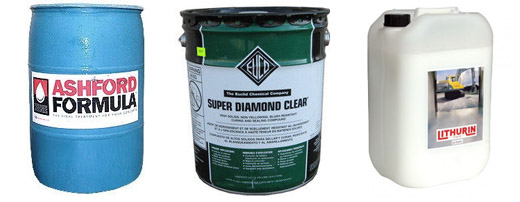Concrete waterproofing: penetrating, liquid rubber, penetron, liquid glass. What materials and methods are used for waterproofing concrete
GD Star Rating
a WordPress rating system
The main event capable of providing comfortable conditions existence, is the fight against dampness in the room. The first material used for waterproofing was animal fat. As an alternative to this expensive water-repellent material, over time, cheaper vegetable fats, tar - a resinous product of dry wood, and natural bitumens began to be used. Vegetable fats and tar became the founders of impregnating waterproofing, natural bitumens formed the basis for the technology for the production of coated and similar rolled waterproofing.
Types of impregnating waterproofing
Impregnation waterproofing, due to its ease of implementation, still has not lost popularity. Some materials of this group remained almost unchanged, for example, drying oil, which is boiled vegetable oil, and tar.
AT modern construction a number of new high-performance impregnations are used: based on oligomeric, acrylic, silicone, epoxy and other synthetic resins.
- As a cheaper alternative to oil impregnation, oligomeric waterproofing has been developed. Such an impregnation is made from products of oil refining and is a material similar in composition and properties to machine oil and diesel fuel. The protective effect of oligomeric waterproofing is based on the non-wettability of carbohydrates. The main difficulty in using such waterproofing is the need to apply it to dry surfaces, which is impossible in already operated damp rooms. In addition, these impregnations contain organic solvents that smell for some time.
Insulating emulsions have been developed to work on wet walls and to remove the smell of organic solvents. In such a waterproofing composition, non-wettable organic particles are distributed in small drops in an aqueous solution. When it hits a wet concrete structure, water carries greasy drops deep into the array. Inside the concrete element, the organic particles stick together, making the concrete waterproof. The most common emulsions are acrylics and silicones.
- Acrylic impregnations It is not entirely correct to call "impregnations". Part of the polymer in the form of a film remains on the surface. More effective are impregnations based on modified acrylic - acrylic-styrenes, methacryls, acrylic-butadienes and other copolymers. This group includes the compositions "Polyrem VD-1624", "Hard", "Elastic", "Folbit 800", "Ceresit ST 17". Close relatives of such impregnations are acrylic and polymer water repellents, which are characterized by deeper penetration into concrete and a less pronounced film on the surface.
- To the group silicone impregnations it is natural to include silanes, siliconates, siloxanes, and other silicon-containing polymers. Despite the difference in the structure of these compositions, they are united by close properties. Silicones easily copolymerize with silicates - sand, cement, gravel, glass, as well as varnishes, paints and plastic materials. The following silicone impregnations are on the market: Aquasil, AC-10, Polyrem VD-1915, Ceresit ST 17. These compositions are recommended for surface application.
The main advantage of silicone impregnations is the ability to form a single whole with the mineral elements of the building by covering the pores, cracks and capillaries of concrete from the inside with a continuous film.
Penetrating waterproofing: types and main characteristics
A new type of protection of concrete structures from moisture is waterproofing for concrete penetrating action. Impregnation can be a colorless liquid, paste or powder diluted with water, but their principle of operation is similar. Water-soluble waterproofing elements penetrate concrete to a depth of 100-300 mm, enter into a chemical reaction with lime, which is always present inside concrete, and other substances. The products formed as a result of this interaction have low solubility in water, so they begin to quickly crystallize out of solution. In this case, crystals of a special type are formed - bundles or brushes of needles, directed with their points inside the pores. The force of surface tension does not allow the liquid to spread, seep between the needles and wet them.
Crystals, occupying a small part of the pore, make it impervious to moisture penetration, but do not completely prevent the movement of steam. Such selectivity of the waterproofing action leads to rapid drying. concrete structure and the formation of resistance to subsequent wetting.
Representatives of penetrating waterproofing: "Viatron", "Gidrosit BS", "Hydrotex", "Carat-P", "Osmosil", "Penetron", "Slurry", "Ceresit СR 90". Some of these materials combine the characteristics of impregnating and penetrating waterproofing.
The combination of Penetron and Penekrit materials is used to prevent water filtration through cracks, crevices, joints, conjugations and junctions. These waterproofing compositions include: cement, quartz sand with a certain granule size, chemically active additives.
In this video, you can see how to apply waterproofing for Penetron concrete with your own hands, and understand the principle of its action (and the action of similar additives):
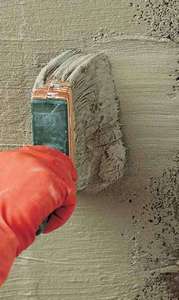
Coating waterproofing properties
At first glance, impregnating and coating waterproofing are similar: they are applied to the surface of a concrete element and penetrate into the body of the material. Their difference lies in the mechanism of their action. The role of impregnating waterproofing is to hydrophobize the surface of pores, cracks and capillaries. That is, the impregnation works in the volume of the concrete element.
The coating composition, on the contrary, works on the surface, penetrating into the material just enough to ensure reliable adhesion to concrete. A great responsibility is assigned to this thin layer, so the requirements for it are very stringent. These requirements are increased if the waterproofing layer is applied from the side that resists water pressure. In this case, the water does not press the waterproofing against the wall, but, on the contrary, tears it off. Therefore, waterproofing must have the following characteristics:
- high adhesion to the protected layer;
- waterproof and waterproof;
- crack resistance and elasticity.
Many requirements, sometimes contradictory, for insulating materials of this group have led to the emergence of many specific types that differ in the degree of modification, phase composition and type of binder.
Difference of coating waterproofing by binder

According to the type of binder, coating waterproofing is divided into mineral and organic.
- Cement-based waterproofing compounds are produced and delivered to the consumer in dry form in bags or plastic buckets. Dry mixtures are put into working condition at the construction site by mixing them with water to a paste state. Work must be carried out immediately after the preparation of the mixture, until it solidifies. Coating waterproofings on a mineral binder include Polyrem SGi-605, Stromix - protection against dampness, Ceresit CR-65, Elastoliqvid, Seal Coat. To enhance the waterproofing properties, a polymer latex dispersion is used. In this case, the waterproofing is called two-component. It goes on sale in a set of two units: dry powder in a bag or bucket and dispersion - in a bucket or canister. The expected effect is achieved only when both components are combined.
To eliminate emergency situations, special compositions are used, the main feature of which is a quick setting in contact with water, and, in the process of hardening, the composition expands. Such compositions are called filling, their family includes: Hydrotex B, Lakhta - water plug, Polyrem SGi-631, Ceresit CX 5, Carat-Fix.
- In a group coating waterproofing on an organic binder, bitumen-based mastics have been and remain leaders. To improve elasticity and increase adhesion to the base, synthetic rubbers and latexes are added to bitumen, which makes it possible to obtain modified mastics. These include Ceresit CL 51 and Ceresit CL 50, which are based on synthetic resins. Waterproofing "Asoflex-R2M-Boden" and "Hyper-Desmo" are made on the basis of polyurethane, "Germo-Butyl-2M-U" - on butyl rubber.
Materials for roll waterproofing
Rolled waterproofing is a bitumen-polymer binder applied to a fiberglass or non-woven polyester base. The upper surface of the waterproofing material is covered with a protective mineral dressing, polymer film or sand, the lower surface is covered with a polymer film.
Fiberglass bases have low elasticity and the ability to perceive a significant tensile force at small deformations. Polyester is a more elastic material and is able to elongate by almost 40% without tearing. Therefore, polyester-based rolled waterproofing is used in structures where its strong deformations are possible.
Before applying the waterproofing layer, the base must be carefully prepared, before the direct laying of the material - primed. The number of layers of rolled waterproofing depends on the strength and type of water load.
There are Russian-made waterproofing materials on the market - Steklobit, Technoplast and imported products - high and low pressure polyethylene geomembranes from NAUE, self-adhesive waterproofing Ceresit BT 21, BT 12, BT 85, BT 85 R, BT 85 SR.
Additives for improving the waterproofing of concrete
In addition to water-repellent materials applied to the surface of building structures, a number of special additives in concrete for waterproofing have been developed. Such compositions, introduced into the concrete mixture during its manufacture, increase the water resistance of concrete. Additives of this group improve not only waterproofing, but also other properties of the material. Waterproofing additives for concrete are made from polymers that have the ability to grow in the concrete mixture, closing cracks and hydrotunnels formed during the hardening of the material.
Technologies for the use of additives are determined by their type. Many dry mixes for waterproofing are used in combination with other modifiers, such as frost-resistant additives and plasticizers.
The ratio of dry composition and water is indicated in the instructions supplied by the additive manufacturers.
The introduction of waterproofing additives into the concrete mixture during its preparation allows you to avoid unnecessary costs for work to protect concrete and reinforced concrete structures from the damaging effects of moisture.
GD Star Rating
a WordPress rating system
Protecting concrete from moisture is an important and easily implemented procedure. For this, a lot of waterproofing and strengthening materials with different characteristics and properties are produced. However, in some cases, it is impossible to get by with only surface protection - something more reliable is needed. This task is best handled by a deep penetration impregnating composition designed specifically for concrete.
Impregnations with deeper penetration are in demand where surface waterproofing is unreliable or short-lived. For example, cement floors in in public places experience severe wear loads. And if the water-repellent layer is not strong enough, it will quickly collapse and the concrete will be left without protection.
Another area of application for deep impregnations is very dense types of high-strength concrete. The pores inside such a material are so small that viscous compounds simply cannot penetrate deeper. But a more liquid deep penetration impregnation has very small particles, 30-60 nm. Due to this, it easily seeps into the thickness of concrete, flowing into the smallest capillary pores and freezing in them.
Almost all waterproofing impregnations, compacting the structure of concrete, slightly strengthen the entire structure. So if you want to improve the characteristics of a very thick screed, you need a solution that penetrates as deep as possible.
For vertical concrete walls, too deep water impregnation is not required, since excess moisture can only flow into surface pores. To block their path, a film-forming composition will be enough.
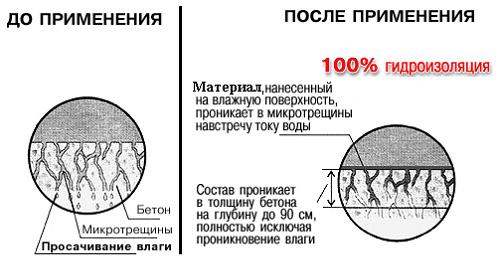
Classification
1. Before you buy impregnation for concrete, you need to decide what properties it should provide to the treated surface. Depending on this, the appropriate composition is chosen.
- Hardening.
Deeply penetrating hardening impregnation for concrete - it would seem that it could be better. But when choosing a mixture, it is worth asking about its principle of operation - perhaps the manufacturer simply throws big words or tries to justify the inflated cost. In order for the solution to increase its strength after penetration and polymerization in concrete pores, it must have special properties.
It is necessary that the strength of the impregnation itself, which has undergone crystallization, be several times higher than at the base. The total pore volume in the cement mortar after it hardens is about 5%. Such an insignificant amount of a hardening additive should be an order of magnitude superior to the characteristics of its “ward”. For low-grade or lightweight cellular concrete, a similar formula can still be selected. But with heavy and durable brands, this trick does not work.
Another thing is if the impregnation changes chemical composition building material, affecting those of its components that are responsible for strength. Therefore, when a hardening formula is required, it is necessary to take a deep penetration mixture that acts at the chemical (molecular) level.
Deep penetration fluorosilicates such as Elacor MB-1 (price 82 rubles/l), the more common lithium impregnation (C 2 Hard) or the good old Ashford Formula silicate polymer costing 645 rubles/kg have such properties.
Chemical impregnation is ideal for outdoor work - it is enough to buy it once so that you no longer have to worry about weather protection. Even the high cost should not be intimidating, since it will "work" as long as the design itself exists.

- Waterproofing.
Quite a useful class of materials that make it possible to make any reinforced concrete structure invulnerable to water. Since this impregnation penetrates deep into the surface of the concrete, the thickness of the insulating membrane created by it is quite large.
In parallel with hydrophobicity, frost resistance also increases - after all, water that does not penetrate deeper than surface pores will no longer be able to exert its destructive effect when it freezes. Continuing the chain of consequences, after applying the waterproofing treatment, we get more durable concrete.

2. There is another option for classifying deep penetration mixtures - by composition. Depending on the main component, impregnation for concrete can be of two types:
- Inorganic.
These solutions change the concrete itself, turning its components into new compounds at the molecular level. It turns out a comprehensive protection from several harmful factors at once and an improvement in its main characteristics. All reinforcing types are made on an inorganic basis.
The Canadian Ashford Formula and its analogues: the American brand Euclid Chemical and the Swedish one turned out to be the best in this business.
- Organic - made on a polyurethane, epoxy or acrylic base.
Fills micropores, thereby sealing and preventing the penetration of moisture that has fallen on the surface deeper. In addition, organic impregnation simultaneously binds the smallest cement dust, and makes the concrete plane resistant to chemically active substances.
The polyurethane composition penetrates into the pores of concrete 2-3 times deeper than other liquids - up to 10 mm. In this case, the uppermost layer, which is most saturated with resins, turns into new material- concrete polymer, which is why its characteristics are noticeably improved:
- wear resistance - 5-10 times;
- brand strength - up to an indicator corresponding to a minimum of M600;
- impact strength - three times.
However, it should be understood that such results can be achieved only if the polyurethane is sufficiently liquid. To do this, it can be diluted with a solvent in a ratio of 1:2 or 1:3. Otherwise, instead of penetrating impregnation, an ordinary film coating will be obtained.
Among organic impregnations, the most popular are domestic formulations of the KrasByt and KrasCo brands. And for old surfaces, it is recommended to use Retroplate (USA).
Application technique
Working with impregnating compounds is not difficult. The liquid must simply be poured onto the concrete floor, trying to spread it evenly over the entire surface. After that, use a soft brush to disperse the mixture over the entire area. If in any of the areas the solution was quickly absorbed, leaving a noticeable dry spot, you need to repeat the treatment.
After about an hour, the concrete should be well moistened with clean water with the same brush in order to restart the chemical reactions that occur in the “working” composition.
- high water repellency
- high penetrating power
- prevents surface dirt retention
- prevents the formation of efflorescence
- frost resistance and crack resistance
- high moisture resistance and vapor permeability
Aquasol is a hydrophobic silicone liquid, water-repellent impregnation for the protection of stone, concrete and brick.
Aquasol- hydrophobic impregnation (moisture insulator) to impart water-repellent properties to various mineral surfaces.
It is a solution of modified polysiloxane resin in organic solvents with functional additives.
Silicone water repellent Aquasol It is used for independent protection against moisture and harmful atmospheric effects of any building materials based on cement: concrete and plaster, ceramic and silicate bricks, composite facade tiles (stylized as brick and stone), aerated concrete and gas silicate blocks, natural and artificial stone (except for gypsum products) ).
Or as a waterproofing hardening impregnation for paints and enamels on organic solvents.
Hydrophobic impregnation Aquasol has a high penetrating ability, significantly increases the strength, moisture resistance, frost resistance, corrosion resistance and crack resistance of building structures. Increases the overall thermal insulation properties of the structure, prevents surface contamination, does not change appearance protected material and its vapor permeability.
Name | Price for 1kg | Price per container | ||
Aquasol 20l | 223 rub./1l | 4 460 rub./canister | ||
Aquasol- concrete water repellant (canister), 10l | 233 rub./1l | 2 330 rub./canister | ||
Aquasol- concrete water repellant (canister), 5l | 247 rub./1l | 1 235 rub./canister |
Consumption calculator
Video
Application
The penetration of moisture into the material, in the form of rain or snow, gradually leads to its destruction. Using a water repellent finish Aquasol(hydrophobization of concrete), significantly reduces the moisture absorption of the material, which can significantly extend the life of the structure and prevent the formation of efflorescence.
Surface treatment with water repellant Aquasol is a necessary measure for a wide variety of construction sectors and objects of various sizes: brick and concrete facades of buildings, plinths, fences, pillars, balconies, canopies, concrete floors, parapets, ebbs, slopes, paving slabs, tiled and slate roofs.
Coating based on hydrophobic impregnation Aquasol retains its protective and decorative properties, subject to the application technology, within 10 years.
Mode of application
Impregnation is ready for use, stir before application. The base must be dry, free of dirt, dust, grease, oils, residues of old coatings.
Application temperature: from +5 to +30°С.
Drying time at +20°C is 8 ocloc'k.
Consumption
Consumption of hydrophobic impregnation Aquasol- 150-250g/sq.m. depending on the type of surface.
Storage
Store in a tightly closed container, protected from heat and direct sunlight, at temperatures from 0 to +30°C. Guaranteed shelf life in the original packaging is 6 months from the date of manufacture.
Price
The cost of water-repellent impregnation - 223 rubles/1kg (20l), 233 rubles/1kg (10l) and 247 rubles/1kg (5l)
Tara
Container 5l, 10l, 20l. Attention! The label is equipped with anti-counterfeit security features.
Technical documentation
Certificate of state registrationCertificate of state registration (attachment)
Expert opinion, page 1
Expert opinion, page 2
Concrete has been popular for many years construction material. Despite the very long history of its origin, concrete has become widespread and recognized only in the last century. Moreover, the volume of concrete produced and used in construction is growing year by year. This demand is quite understandable: concrete is a universal material of high strength and a wide range of uses.
But there is a characteristic of this material that I would like to improve or at least compensate for. Despite all its hardness, the water-repellent properties of this material are poor. If you look closely, even with the naked eye you can see the smallest pores on the surface. Moisture can penetrate deep into the material through these pores. With prolonged exposure to dampness and temperature changes, concrete products and structures can collapse.
To solve the problem of structural deformations and thermal microfractures of concrete, mandatory actions are needed to waterproof the concrete surface. This is especially necessary if the concrete is used in conditions of high humidity or in contact with water: foundations, garage floors, pools, etc.
Concrete waterproofing
There are many materials and methods for waterproofing concrete. The choice of a suitable solution will depend on the place of application, and on the area of processing, and on the intensity of operation, and on the possible budget.
Concrete waterproofing options:
- penetrating waterproofing for concrete;
- additives in concrete for waterproofing;
- liquid waterproofing for concrete;
- coating waterproofing for concrete;
- glued or built-up waterproofing;
- concrete sealant.
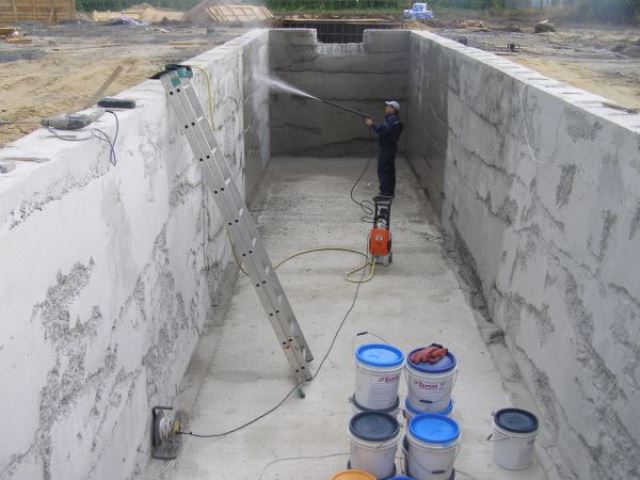 Penetrating waterproofing
Penetrating waterproofing Penetrating concrete waterproofing
Cement-based waterproofing, although it was known 50 years ago, did not find wide application then.
The principle of operation of penetrating waterproofing is that the chemical elements included in its composition, after hitting the wall surface, penetrate under the action of physical forces into microcapillaries in the thickness of concrete. The name of this method of waterproofing comes from the ability to penetrate the wall.
In the capillaries, the active ingredients of the mixture interact with the substances that make up the concrete. Further, a kind of micro-plugs are formed, which completely clog the movement of the liquid from the inside, but do not reduce the vapor permeability of the wall.
For a long time, Penetron cement-based dry mix for waterproofing has been synonymous with penetrating concrete waterproofing. This is due to the fact that Penetoron has long been the only such remedy. But today, waterproofing mixtures from many other manufacturers are presented on the construction market.
Penetrating mixture for waterproofing is available in dry form. After mixing with water, it is applied to the concrete with a wide brush with synthetic bristles. Mix the solution immediately before work and in an amount that can be spent within 30 minutes.
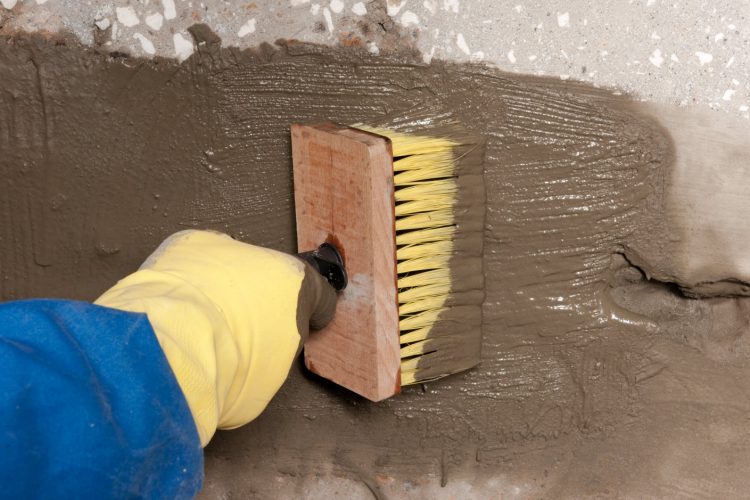 Cement based waterproofing
Cement based waterproofing Additives in concrete for waterproofing
To improve the inherent characteristics of concrete, various additives are added to its composition at the stage of making the mortar. Additives make concrete waterproof or hydrophobic.
hydrophobic concrete
This concrete, after hardening, acquires the property of repelling water from its surface.
The following types of additives are used:
- paraffins;
- calcium salts;
- stearic acid;
- salts of naphthenic acids;
- petroleum acids;
- resin.
An additive in concrete for its hydrophobicity can be hydrophobic (an immiscible admixture with certain characteristics) and hydrophobic (giving a water-repellent effect when interacting with concrete substances).
waterproofed concrete
Using waterproofing additives in concrete, it is possible to obtain a material with a lower air content. Waterproofing additives in concrete compact the mixture and increase the concrete's own resistance to moisture.
Waterproofing additives include:
- ferric chloride;
- calcium nitrate;
- silicate adhesive.
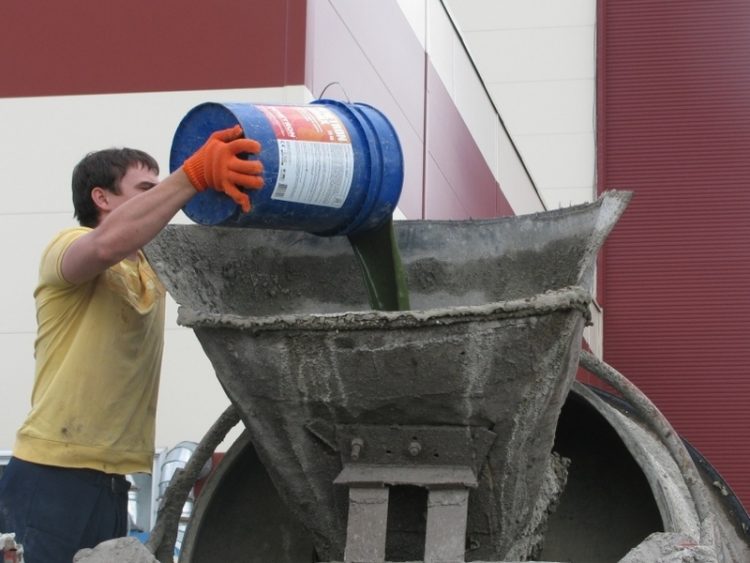 Additives in concrete for waterproofing
Additives in concrete for waterproofing Waterproofing impregnation for concrete
Liquid impregnation for concrete waterproofing is of two types:
- Deep penetration (mixtures based on silicates). Such impregnation significantly increases the strength of concrete, which causes a waterproofing effect.
- Surface protection waterproofing (based on epoxy, acrylates, polyurethanes). Such impregnations create a film on the surface and prevent the liquid from seeping into the concrete, but do not affect its strength.
This type of waterproofing is one of the easiest to apply. Liquid waterproofing composition is enough to apply on the vertical concrete surface roller or brush. Horizontal surfaces, such as floors or ceilings, are most conveniently waterproofed. It is enough to pour the impregnation in a thin layer, distribute it evenly with a soft brush and allow to dry.
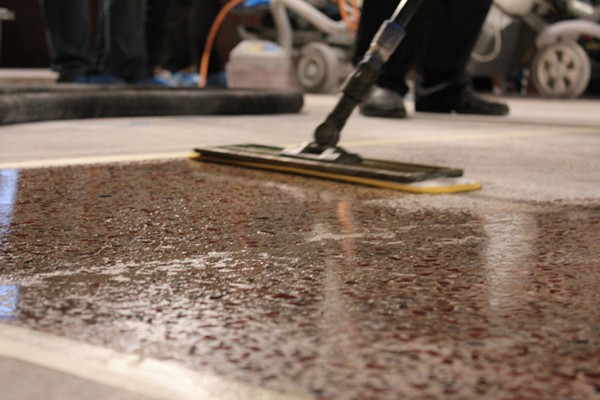 Waterproofing impregnation
Waterproofing impregnation Mastic for concrete waterproofing
Mastic waterproofing is very popular for various reasons. This is a fairly affordable way to protect concrete from the harmful effects of moisture. The mastic is easy to apply, has sufficient fluidity to create an even coating during the drying process. In this case, the coating is smooth, without seams and joints.
Mastic can be used both in air and in contact with soil, protecting concrete equally well from atmospheric precipitation, and from ground and melt water.
There are two main types of mastics for waterproofing:
- Bituminous mastic. One of the cheapest and oldest waterproofing for concrete. The main component of such a coating is bitumen. Hot bituminous mastic is applied. Polymer additives are added to the material to improve the fluidity, polymerization and elasticity of the cooled coating. In addition, additives allow you to apply bituminous mastic in a cold way.
- Polyurethane mastic. Made from acrylic. When dried, it completely polymerizes, creating a dense protective coating on concrete. The advantages of polyurethane mastic in drying speed, resistance to ultraviolet radiation. Hydrophobic acrylic mastic is also good because you can add a dye to it and tint the coating to the desired color. Also, acrylic-based mastic is lighter than bituminous.
It is convenient to use a mastic coating for waterproofing surfaces of complex relief, as it is applied with a spray gun, less often with a brush or roller. At the same time, you can be sure that both external and internal corners will be well processed.
The mastic layer for the best result can be up to several centimeters thick. The minimum allowable thickness is 1 mm.
 Mastic for waterproofing
Mastic for waterproofing Bonded and built-up coatings for waterproofing concrete surfaces
Waterproofing concrete using roll coatings is one of the most traditional. Materials are made on the basis of bitumen. Coatings of the old generation had a significant drawback - great fragility, which created difficulties both during installation and further operation. Now, polymers are added to the bitumen used for the manufacture of rolled waterproofing, which significantly improves the characteristics of the material.
Bitumen-based roll waterproofing is divided according to the principle of installation into:
- Okleichnaya. For laying waterproofing, the surface is pre-coated with bituminous mastic. Next, lay the waterproofing itself, carefully level it. The joints are overlapped, they are glued with mastic. Waterproofing can be done in several layers, alternating mastic and roll material.
- Surfacing. Such waterproofing is bonded to the coating using burners. The material is rolled over the surface and warmed up. The mastic layer melts and sticks the canvas to the base. The joints are also overlapped.
 Fused waterproofing
Fused waterproofing Sealant for concrete
Sealant is used when it is necessary to waterproof small cracks or seams in concrete. Exists a large number of a variety of sealants that differ in the main ingredient: rubber, bituminous, silicate, silicone, acrylic, polyurethane, etc.
Three of them are the most popular:
- acrylic sealant. Made from acrylic. By and large, it's more of a putty. It does not waterproof very well, but it can fill large spaces, levels well and paints beautifully after drying;
- Polyurethane sealant. Fast bonding to the surface, after polymerization and drying has high strength. Perfectly proved itself for sealing seams and joints between plates. Paint may be applied over the dried polyurethane sealant;
- Silicone sealant. Most used and popular. The best protection against moisture and dampness. It can be used on different surfaces as it has high adhesion. The downside can be considered its immunity to staining - the paint simply does not hold on dried silicone sealant. But there are already tinted silicone sealants.
Silicone sealants can be acid and neutral. For work on concrete, only neutral silicone sealants are used, since acids, reacting with substances from concrete, can destroy both the concrete itself and the sealant.
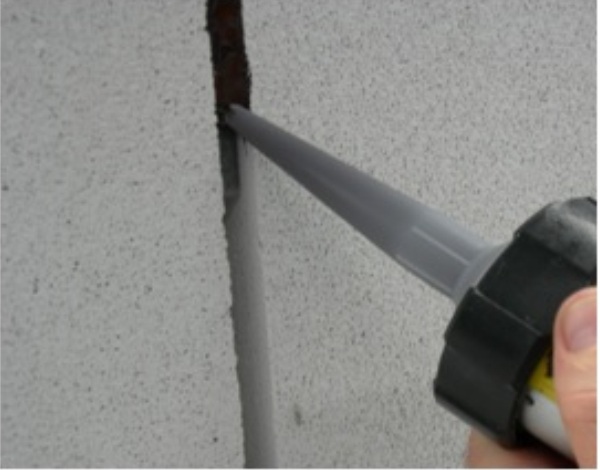 Sealant for concrete
Sealant for concrete
Liquid glass is a substance that is a mixture of sodium and potassium silicates. The composition of liquid glass is similar to stationery glue. The silicates that are part of the liquid glass react with the components of concrete and clog microcracks in layers close to the surface.
Liquid glass is a penetrating waterproofing. It is applied very simply - with a brush or roller. You can do the work yourself. But, it should be noted the fragility of the composition after drying, therefore, such waterproofing requires protection from mechanical damage.
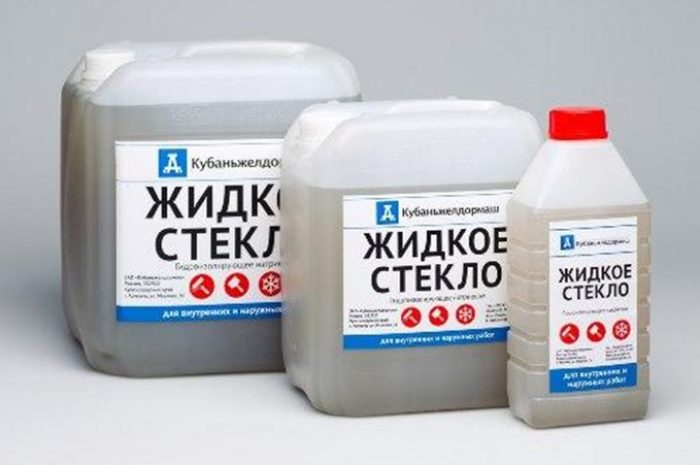 Waterproofing concrete with "liquid glass"
Waterproofing concrete with "liquid glass" In principle, when using cement mortar High Quality and high inherent strength, as well as when creating certain conditions for molding and drying, it is possible to obtain practically waterproof concrete. Such concrete is used in the construction of high-rise buildings and structures for special purposes. Under normal conditions, it is very difficult to make such concrete. Especially when it comes to low-rise private construction.
To increase the service life of buildings and to reduce the influence of the destructive effect of moisture on them, waterproofing of concrete is necessary. Various materials can be used for this: sealant for concrete; hydrophobic additives for concrete; mastic for concrete; welded or glued rolls. The main thing is that the waterproofing is suitable, and the processing is done professionally.
The compositions of the waterproofing agent form a waterproof film on the surface of the materials, which not only does not let moisture in, but also clogs the pores in the materials, and also waterproofs microcracks in concrete.
Penetrating waterproofing is used for building structures, buildings and structures from water penetration, the harmful effects of washing, filtering water or other aggressive liquids. It ensures the normal operation of buildings, structures and equipment, increases the grade of concrete, namely its reliability and durability.
Varieties of waterproofing
Penetrating waterproofing - penetrates into pores to a depth of 20 cm, reliably filling even microcracks.
Coating waterproofing are mastics and bitumen-containing compounds used to protect walls from capillary moisture and groundwater.
Adhesive waterproofing - used to quickly create a waterproof layer on horizontal and vertical surfaces, wall joints, to protect seams, cracks. Not applicable everywhere.
Painting - used to protect against capillary moisture. Paint waterproofing is environmentally friendly, economical, permeable to air and water vapor.
Powder - dry powder is diluted with water before use. Easy to use, effective, but easily susceptible to mechanical damage.


